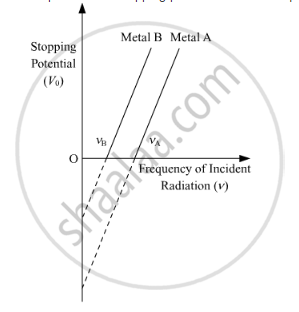Advertisements
Advertisements
प्रश्न
Sketch the graphs showing variation of stopping potential with frequency of incident radiations for two photosensitive materials A and B having threshold frequencies vA > vB.
(i) In which case is the stopping potential more and why?
(ii) Does the slope of the graph depend on the nature of the material used? Explain.
उत्तर
(i)
Graph between stopping potential and the frequency of the incident radiation:

From the graph, we note:
(i) The stopping potential is inversely proportional to the threshold frequency. Hence the stopping potential is higher for metal B.
(ii) The slope of the graph does not depend on the nature of the material used.
As we know,
Kmax= hv − ϕ0 = eV0
Dividing the whole equation by e , we get
`(hv)/e-phi_0/e=V_0`
From the above equation, the slope of the graph is `h/e`(on comparing with the straight line equation). Thus, we see that the slope is independent of the nature of the photoelectric material.
APPEARS IN
संबंधित प्रश्न
The photoelectric current in a photoelectric cell can be reduced to zero by a stopping potential of 1.8 volt. Monochromatic light of wavelength 2200Å is incident on the cathode. Find the maximum kinetic energy of the photoelectrons in joules. [Charge on electron = 1.6 x 10-19 C]
Write three characteristic features in photoelectric effect that cannot be explained on the basis of wave theory of light, but can be explained only using Einstein's equation.
Light of intensity ‘I’ and frequency ‘v’ is incident on a photosensitive surface and causes photoelectric emission. What will be the effect on anode current when the anode potential is increased? In each case, all other factors remain the same. Explain, giving justification in each case.
If the total energy of radiation of frequency 1014 Hz is 6.63 J, calculate the number of photons in the radiation. (Planck’s constant = 6.63 x 10–34 J.s.)
What change will you observe if intensity of incident radiation is changed but the frequency remains the same?
A beam of monochromatic radiation is incident on a photosensitive surface. Answer the following question giving reason :
On what factors does the number of emitted photoelectrons depend?
In photoelectric effect, why should the photoelectric current increase as the intensity of monochromatic radiation incident on a photosensitive surface is increased? Explain.
Draw a plot showing the variation of photoelectric current with collector plate potential for two different frequencies, v1 > v2, of incident radiation having the same intensity. In which case will the stopping potential be higher? Justify your answer.
Calculate the momentum of a photon of energy 6 x I 0-19 J.
Photoelectric effect is possible ______.
